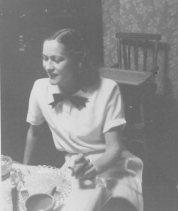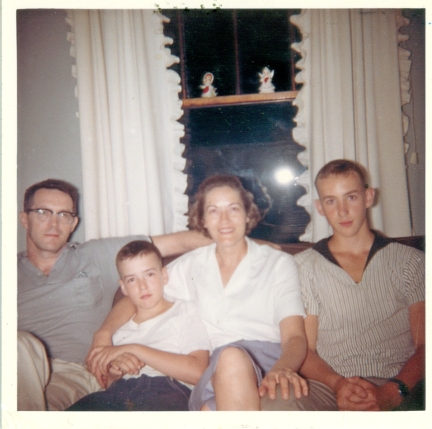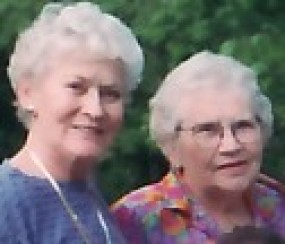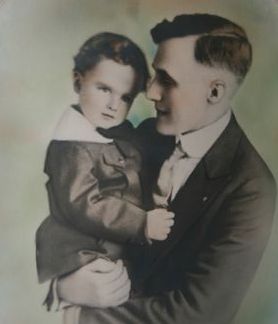Happy 100th Birthday, Erma Maxine Johnson Foutz
I first learned about loss — and renewal — from my grandmother Erma Foutz.
I was very young, barely 4, when my grandpa Foutz died of lung cancer in 1980. My memories of him were mere brushstrokes, though his legend loomed ever after.
My lessons took place in the years following his passing. In visits to her home on Cross Street in Dover. First it was only Grandma there, and not that grayer, grizzlier shadow of my own father moving around in the basement, or outside, or upstairs.
Later, after Grandma remarried and spent much of her time in Arizona with second husband Max Miller, the house was a place my dad looked after, mowing the lawn, or picking up the sour, mushy crab apples. I’d climb the tree out back, or lie on the rug in the pantry, coloring, or putting together puzzles from the old tin.
It was odd, for a few years, driving around in Grandma’s green Pontiac Sunfire, scooting “over the hump” in the backseat on our way to church, or Pre-K, instead of her pulling up outside our house, coming in for Christmas Day, or a picnic.
In the years immediately after Grandpa’s passing, there were odd, magical moments, fueled by a gradeschooler’s imagination, where I thought I’d discover him someplace else. Selling popcorn in our neighborhood, stopping at the house a few doors around the corner — wasn’t that? Couldn’t that be him? Or a gruff laugh in the back of a school gym.
The renewal happened not long after. Grandma married a longtime friend and former boss, Max Miller, on New Year’s Day, 1982, in Phoenix.
“Uncle Max” as we called him early on, and later, just Max, was a jolly, joking, face-pulling sort to the many grandchildren in his and Grandma’s brood. He brought books, and exotic souvenirs — fisherman’s caps from Scotland, and carved elephant door handles — and multiple carousels of slides from his world travels, which Grandma gleefully, gratefully joined him on.
I wasn’t too young to see how Grandma flourished in that friendship, that love, in her later years. She’d been born as poor as they come, I guess. Sharing a bed with her two sisters, and a house with nine siblings, moving every few years throughout her childhood in New Philadelphia. She was a literal coal miner’s daughter. But a lively sort — so the stories, heard later on from her sister Nellie, said — with a partner or two at every dance, and a yearbook full of admiring inscriptions.
She talked, later, of wanting badly to attend college. She did not, but trained as a secretary, and joined a local sorority, when that was possible, among the young working gals in Tuscarawas County.
She met my grandfather, Don, from crosstown rival Dover, when he’d already set a toehold into his working years. Six years her senior, he was already enough of a shadow of the football legend — almost a decade removed from his famous exploits in the 1931 season, and three straight rivalry games with her New Philadelphia Quakers, and some five years removed from a brief second-gasp shot with Ohio State, cut short. He was already punching the clock at Potschner Ford, while she was typing away in the offices at Greer Steel, his eventual destination as he wound out the decades.
I had no notion of them as a couple, but there must have been great love and devotion there. And music. One of grandma’s prize possessions was an organ that sat, for years, in her living room on Cross Street, then made the move through a succession of Dover and New Phila apartments, with Max, before a deluxe version settled in a corner of the family room — across from Max and Erma’s bar — in their Country Club Drive dream home.
But that was later.
Music: Grandpa was a fan of jazz and swing bands. And it’s said they used to dance. There was nobody who danced like they did. The floor cleared, and the crowd clapped and watched. Music.
Grandma made her own sweet music with Max through 18 years of marriage. And no matter their world travels took them — to Europe, to Africa, to Antarctica; their home away from home in sunny Sun Valley, Arizona — their path inexorably wound back through Tuscarawas County.
We continued the tradition of family Christmas Eves — first at the house on Cross Street, then in their apartments and that lovely home atop the hill in New Phila. We slapped down cards in Skip-Bo, and flipped through the countless photo albums. Slides gave way to VHS tapes, DVDs. But the best moments — the best moments — were lunches with just the two of them, 2-on-1, cold cut sandwiches and cold cans of pop, something mellow on the in-wall speakers. Talking about school, and girlfriends, and my own affair with music. My own prized possession is the honey-brown Yamaha console piano Grandma and Max bought me (well, my family) during a trip up to Canton one school night my sophomore year. It’s followed me to a succession of houses in Illinois and Sioux Falls, South Dakota.
And grandma’s memory follows me still. She was second of my grandparents to pass away, 20 years after grandpa, in 2000. I was just out of college, winding out my time in Pittsburgh, unsure of the next step, the first job. In the last conversation I remember with her, late that June or July, when she was noticeably less, her constant whirl of motion dulled by the cancer she was fighting, the phone rang in my little attic apartment and it was her. She was a prolific letter writer — in beautiful, flowing script — and spontaneous caller throughout my college years. At the end of our conversation, she had a message just for me, that has touched me all these years. She said: of all her grandchildren, that I’d pursued music and writing, and that my cousin, Whitney, had pursued architecture, these were closest to the arts she herself had wished she’d studied. That was the last time we spoke.
One of the lasting gifts Grandma and Max gave, too outsized and profound for the young man I was to really grasp back then, were the trusts they’d established for each of their grandchildren, making it possible for all of us to pursue our educations, and graduate school and continuing education in many cases, and extend to the down payments to our first homes, our transportation to and from those first jobs. Their generosity, and their great love for family is their legacy.
Today would have been Grandma’s 100th birthday. As I’d done before, first with Grandpa Don Foutz, and in 2018 with Grandma Sue Ley and Grandpa Bob Ley, I’m sharing the collection of images I’ve kept on my computer to trace their remarkable lives, in memory of all they’ve given us, and in how we remember them still.
Erma Foutz: 79 Years in Photographs
(Scroll to view the gallery below, or click any photo for a closeup slideshow.)






















































